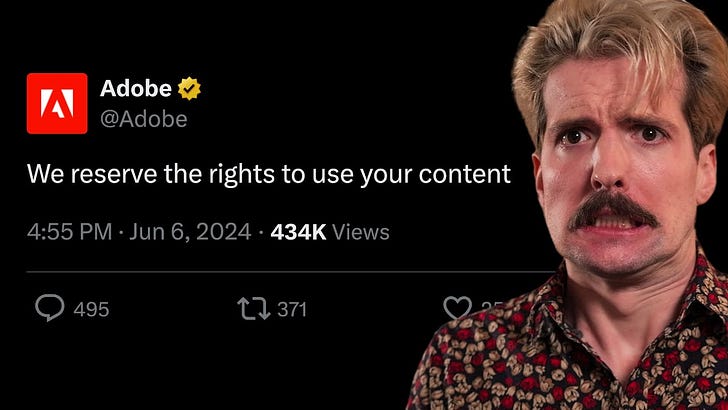
Once upon a time, I was a Adobe fan boy.
In the past week, with Adobe’s updated Terms Of Service causing a bit of a shitstorm online, I was reminded why I decided to give up my subscription.
Not only had the price gotten far too high, the company seems to think its customers have no choice but to use them. And while most corporations prefer to license from “industry leaders” like Adobe, freelancers and small businesses are more willing and able to try new tools and see what works best for them.
I started my design career unable to afford (legal) entry into the Adobe world. And didn’t like the idea of using “liberated”/pirated software. Then or now.
So, for the first few years, I used Macromedia Fireworks to design everything from websites big and small to small business branding.
Not a conventional choices, but, for me, it was the best of Adobe’s Photoshop and Illustrator…at a price most designers could afford. (If memory serves, my first copy came as a freebie with a scanner I bought.)
And then, in 2005, Adobe bought Macromedia.
The final release of Fireworks, Adobe Fireworks CS6, was in 2012, right before the company launched the subscription-based Adobe Creative Cloud in 2013.
With both independent artists and designers and corporations big and small paying for licenses, the company had money to burn. And seemed to be spending it on innovations…and acquisitions.
Based on the annual Adobe MAX conventions I attended, the profits were pouring in.
Long story short: Creative Cloud is a good deal. And a not-so-good deal.
In 2012, I was paying ~$1K every year or so for a new “version” of the Creative Suite.
Creative Cloud’s monthly plan started out cheap: $19.99 if memory serves. Then the price went up. And up. And up. And UP. It’s currently $59.99 a month.
While still less than before, if you read the Terms Of Service (and who does really?) there are now a lot more strings attached to all those bells and whistles.
Less focus on innovation, more focus on moderation.
Slowly but surely, services like Adobe Stock became as important as products like Adobe Photoshop. While Adobe had long been the 800-pound gorilla in the room, they became what I consider a monopoly.
Any company considered “too big to fail” tends to become so big they flail…fast.
By 2020, in the first wave of COVID-19 lockdowns, I was working 10-12 hours a day on a corporate job, using Adobe Creative Cloud. The job was stressful and Adobe’s bloated and buggy software didn’t help matters. So any free time I had was often spent testing software alternatives…and plotting my exit from that job.
I was looking for alternatives because, frankly, I was sick and tired of helping Adobe and my now-former employers become bigger corporate monsters.
And not the good kind of monsters…with cookies. They increasingly only offered crumbs. So my cookie finally crumbled.
My search for software alternatives was relatively short:
On iOS: Procreate was fun (and useful) for art and concepting, but not exactly the Photoshop “replacement” I needed.
On Mac: I tried and bought Affinity Photo. In May 2020.
So why did I wait until June 2023 to give up my Adobe Creative Cloud subscription?
Uh, well, uh…it can be harder for “old dogs” to learn new tricks and start new careers.
Long story short: While it’s been a mixed bag of nuts, leaving both Adobe and the company I worked for were necessary steps in my own personal and professional development. Neither were easy or fun decisions.
Like most people, I’m doing the best I can with the talent and tools I have.
I’m sure those working for Adobe are too. Or at least doing their best to increase profits for their stock holders. Cuz that’s what corporations are in business to do.
No regrets walking away from almost 20 years of using a really good software suite. Affinity is a really good alternative. Not perfect. But no one and nothing is.
Thanks for reading!
Clint
MORE FROM COLLIDE PRESS
Ko-Fi + Linktree + Shop + Storefront + YouTube
















